The stormy life of galaxy
DOI: 10.1063/PT.3.4112
It’s 1902 and astronomer Max Wolf is confused. Scrutinizing photographic plates of the star-poor region near the north pole of the Milky Way, in the constellation Coma Berenices, he spots an unusual concentration of fuzzy patches. In his article, “Die Nebelflecken am Pol der Milchstrasse” (“The fuzzy objects at the pole of the Milky Way”), Wolf provides meticulous descriptions of those objects, their sizes, and their morphologies—elliptical, spiral, and core brightened. He concludes with the understatement, “It would be premature to speculate on this strange result. Nonetheless, I must not miss pointing it out for general attention.” 1
Thirty years later Wolf’s fuzzy nebulae were shown to be island universes, what we now call galaxies, and first hypothesized by German philosopher Immanuel Kant. Today, Wolf’s collection of galaxies is known as the Coma cluster—its central region of massive galaxies is shown in the opening image. They are each comparable in size to our own Milky Way, with hundreds of billions of stars.
But another mystery emerged in the early 20th century. Using the Doppler shifts of galaxies in the clusters, astronomers calculated that about 400 times the mass of the stars themselves would be required to keep clusters like Coma gravitationally bound. In 1933 the brilliant and eccentric Swiss astronomer Fritz Zwicky attributed that extra gravitational force to some unknown “dunkle Materie,” 2 or dark matter, whose nature remains a mystery to this day.
A brief glimmer of hope that dark matter might have been found appeared in the 1970s when astronomers discovered that clusters of galaxies were filled with an x-ray-emitting plasma—the intracluster medium (ICM)—at a temperature of 107–8 K degrees. But estimates of its mass quickly established that it too fell far short of being able to bind the cluster. The ICM contributes only about 13% of the 1045 kg that make up the most massive clusters. Dark matter, whatever its nature, continues to dominate the overall cluster collapse and subsequent dynamical evolution.
Both computer simulations and observational studies of the three-dimensional distribution of mostly dark matter show that it is concentrated into filamentary structures that become evident approximately a billion years after the Big Bang (see Physics Today, March 2007, page 20
The opening image belies the sometimes violent and very long time-scale motions present as a cluster evolves over billions of years. A sped-up view would reveal a stormy mélange of interactions between the cluster’s diffuse plasmas, galaxies, and dark matter. The challenge is to re-create that evolution from sparse snapshots at different wavelengths.
Storm chasing
Clusters evolve relatively simply at first as material begins to fall into them, but shocks and other features soon develop in the diffuse plasma of the ICM. With densities of only 102–4/m3, the ICM has an enormous particle mean free path of about 1017 km. In that extreme “collisionless” plasma, which is not seen anywhere on or near Earth, interactions are driven by plasma wave scattering. With its high ratio of plasma to magnetic field pressures, the ICM plasma provides bountiful opportunities to investigate interesting questions far beyond the reach of a terrestrial lab: Which types of plasma waves dominate? How do plasma structures transfer energy to different spatial scales? How can ions and electrons reach equilibrium with each other? How do magnetic fields and cosmic rays co-evolve? 3
The radiative processes of two cluster-wide plasmas help astronomers reconstruct the history of the cluster. The x-ray-emitting ICM plasma reveals itself through free-electron collisions with ions (thermal bremsstrahlung); the radio-emitting cosmic-ray plasma shows itself through synchrotron radiation generated when relativistic electrons spiral around a magnetic field. The ICM also creates distortions in the cosmic microwave background spectrum that can help in diagnosing ICM properties. The cosmic microwave background photons first pass through the cluster. On their way to Earth, they experience inverse Compton scattering off hot electrons in the thermal plasma. The mechanism, known as the thermal SZ effect, was named for Rashid Sunyaev and Yakov Zel’dovich, who first described it 4 in 1972. Magnetic fields provide yet another diagnostic tool, since they regulate the brightness and polarization properties of the synchrotron radiation. With typical strengths of 0.1–1 nT, the magnetic fields physically couple the thermal and relativistic plasmas and influence both the transport of heat in the ICM and the energization of the cosmic rays.
All those processes reveal different aspects of the plasmas, which astronomers use to determine densities, temperatures, the presence of shock waves, and other transient features in the ICM. They would love to watch the time-lapse maps of the radio and x-ray emissions to chart the passage of shocks and the generation and dissipation of turbulence. Unfortunately, the crossing time for clusters can approach a billion years, a bit beyond the typical astronomical career. But fortunately, weather vanes in clusters form when low-density and usually bipolar jets of plasma are ejected from supermassive black holes at the centers of some galaxies, the so-called active galactic nuclei. Those jets are deflected and distorted in their relative motion through the ICM and provide important insights into the dynamics of the thermal ICM plasma.
Gentle storms
Clusters have been growing over the past 10 billion years through the continuing infall of material, mostly clumps of dark matter, primarily along the filamentary structures. In some clumps, the accompanying baryonic matter has cooled sufficiently for stars and galaxies to form. Once those relatively compact galaxies reach the denser environment of the cluster cores, they are scattered by local irregularities in the gravitational potential. That process will eventually lead to an isotropic distribution of orbits and a situation known as “virial equilibrium,” where the galaxies’ average kinetic energy equals one-half the magnitude of their average gravitational potential.
But for the infalling baryons still in a diffuse state, a quite different fate is in store. The high kinetic energy from their gravitational infall is converted into thermal energy in the outskirts of the cluster, which slows the infalling material’s velocity. That conversion happens at the so-called accretion shock, which causes a jump in density and temperature. Those shocks have been seen in computer simulations but not yet in observations. After conversion of its kinetic energy, the plasma—part of the ICM now—reaches a temperature of about 108 K, hot enough for astronomers to detect its radiation in x rays. As the stars in the cluster galaxies continue to age, winds and shocks transport stellar-processed material into the ICM, enriching it with elements, from carbon to iron, produced inside stars.
If that infall continues at a slow pace and without colliding with another massive system, the cluster can reach a relaxed state. While the higher-density galaxies approach virial equilibrium, the diffuse ICM reaches hydrostatic equilibrium, where gravity balances the gas pressure. Under those gentle conditions, a massive central galaxy 1013 times the mass of the Sun (M☉) can form with a supermassive black hole at its core. In the cluster’s inner regions, the radiative cooling time for the ICM is shorter than the age of the cluster, so central regions actually become colder than the diffuse medium farther out. Such relaxed clusters have high x-ray luminosities due to their high central densities. They are prominent in cluster surveys, where they are recognized by their bright, central x-ray cores, their Gaussian distributions of galaxy velocities, and their generally symmetric appearance.
That apparent cluster relaxation can be deceiving. If the smooth component of the cluster x-ray emission is filtered out, a new level of complexity reveals itself (see figure
Figure 1.

When a massive cold clump of baryons and dark matter grazed the central region of the Perseus cluster, spiral-shaped ripples formed in the intracluster medium (ICM; orange, filtered from x rays). The image covers 400 000 parsecs; courtesy of Stephen Walker, NASA’s Goddard Space Flight Center. The bright white patches show starlight from the cluster galaxies; they were observed with a 660 nm wavelength image from the Sloan Digital Sky Survey. Contours outline the corresponding synchrotron radiation from the relativistic plasma; courtesy of Marie-Lou Gendron-Marsolais, University of Montreal.
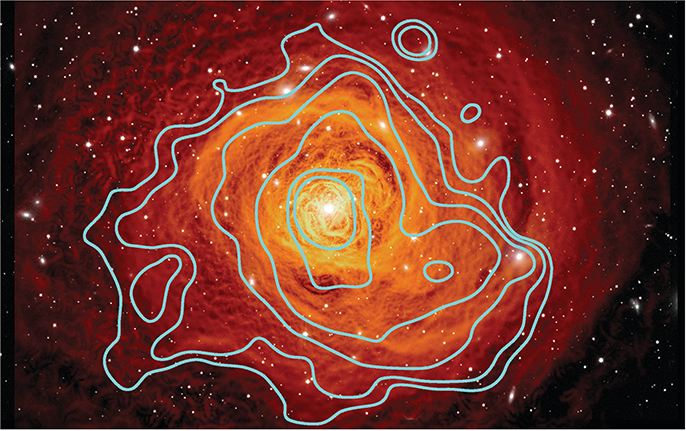
The Perseus cluster, seen in figure
Violent storms
When astronomers are lucky, they can catch one of the rarer major collisions between clusters of comparable mass. The Bullet cluster, seen in figure
Figure 2.

The Bullet Cluster. X rays (pink) illuminate what remains of the intracluster mediums (ICMs) after a two-cluster collision. The clump on the right—one of the cluster’s original, dense ICM cores—now generates a pressure-matched, bow-shaped feature in the surrounding ICM. The small cross sections of the galaxies (white) and dark matter (blue) allowed them to pass through each other with no interaction. (X ray: NASA/CXC/M. Markevitch et al. Optical: NASA/STScI; Magellan/U. Arizona/D. Clowe et al. Lensing map: NASA/STScI; ESO WFI; Magellan/U. Arizona/D. Clowe et al.)
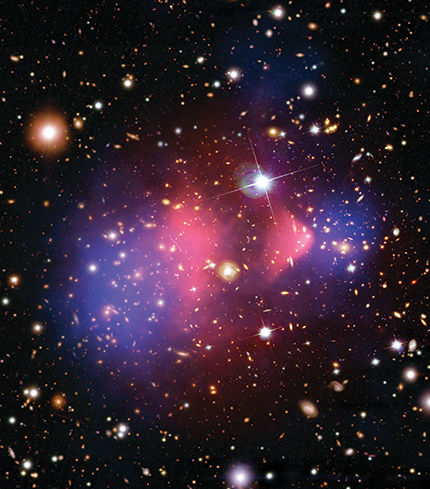
Looking at the synchrotron emission from cosmic-ray electrons and magnetic fields reveals additional information about stormy, multicluster mergers. Figure
Figure 3.

The Abell 2256 cluster, generated from a multiple cluster merger, shows a rich variety of structures. Purple indicates the 2–10 keV x-ray emission from the intracluster medium (ICM). Orange shows the starlight from cluster galaxies in the near-IR band. Radio synchrotron emission from cosmic-ray electrons is displayed in green, and the contour indicates the extent of the diffuse synchrotron “halo.” Yellow indicates a few of the cluster galaxies with supermassive black holes, whose radio jets have been distorted by relative motion through the ICM. (Adapted from ref.
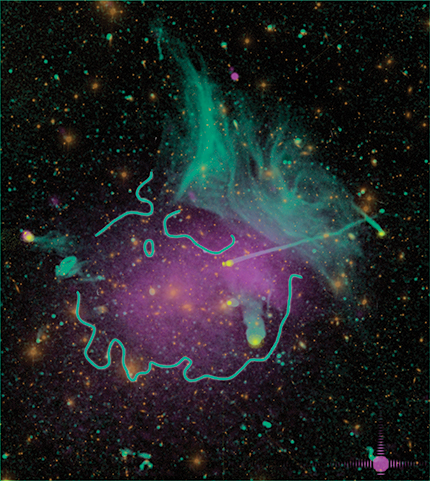
That energy is thought to be supplied by a great deal of turbulence throughout the ICM that not only accelerates the cosmic-ray electrons but also amplifies the ICM magnetic field. Looking beyond the central regions, the source of energy powering the dramatic filamentary synchrotron feature, shown in green in the upper right of figure
When shock structures can be simultaneously detected in the two plasmas—radio and x-ray emitting—then astronomers can use that information to reveal the energetics and dynamics of the cluster merger. A textbook example of such x-ray and radio shocks is seen in figure
Figure 4.

Radio emission from the Toothbrush cluster illuminates an upward-moving shock at the northern edge of its parent cluster. A profile of the x-ray emission along a vertical line through the brightest radio region from the downstream (postshock) to upstream (preshock) material is shown sideways on the right. A brightness discontinuity, the x-ray signature of a shock, can be seen at the same location as the radio emission feature. (Adapted from ref.
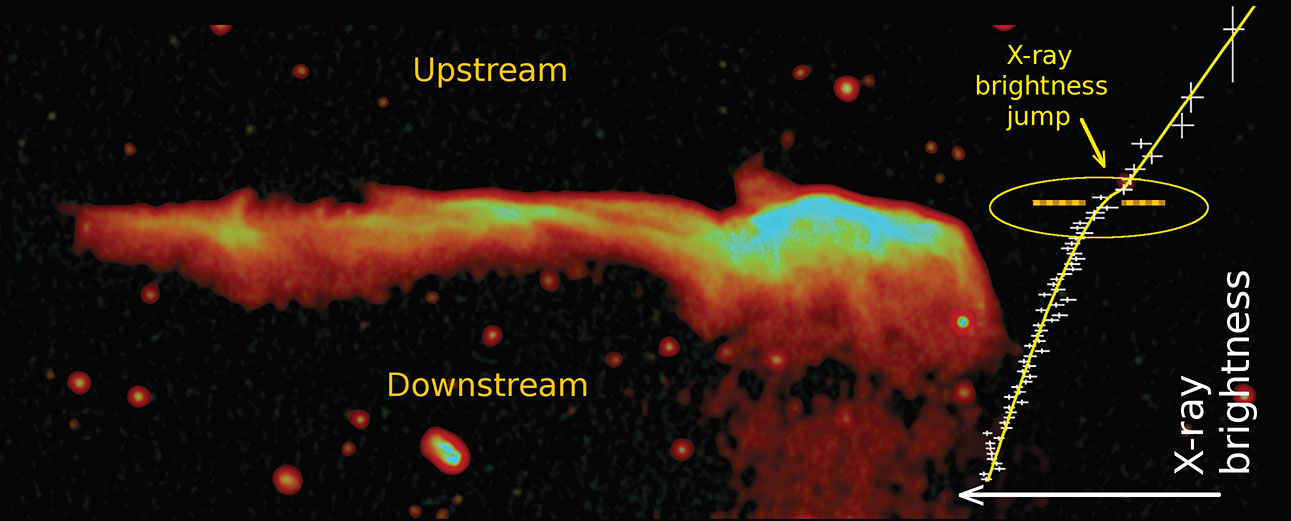
Because astronomers do not observe the radio preshock emission, they can’t use the same kind of diagnostics to estimate the shock Mach number as they do for the x rays. However, astronomers know that cosmic rays can be energized at shocks, as is seen in solar flares. In a simple, idealized model of shock acceleration, often called diffusive shock acceleration, the cosmic-ray population follows a power law in energy, N(E) dE ~ E−s dE. The synchrotron spectrum can be used to infer the power-law exponent, s, which is physically related to the Mach number. Observations of the Toothbrush relic reveal that instead of the very low x-ray-derived Mach number, the synchrotron-derived value is about 3.5. To first order, it’s reassuring that those simple theories with very different underlying physics for interpreting the radio and x-ray observations both lead to low Mach numbers. But at second order, the discrepancies have led astronomers to look deeper at the uncertainties in both our observations and models.
Looking back at figure
The physics beneath the weather
One especially interesting and unanswered question arises from the radio synchrotron emission: What are the mechanisms by which the shocks and turbulence in the thermal plasma transfer energy to a small but highly energetic population of cosmic rays? The answer appears to lie in the smallest scales of the turbulence, where repeated scattering of electrons by self-excited and other magnetohydrodynamic waves slowly restores the energy that radiated away. Simultaneously, the magnetic fields required for synchrotron radiation start at very weak strengths as the cluster starts to form by processes that are currently unknown. Then shear motions in the turbulent ICM stretch the embedded fields and strengthen them by large factors. A better understanding of such a complex set of interconnected processes requires numerical simulations.
But numerical simulations of cluster plasmas face huge challenges. They need to start with two large-scale phenomena: the inflows of magnetized thermal plasma that originate during cluster formation and the more dramatic merging of clusters. At the same time, simulations must incorporate how turbulent energy dissipates on the smallest scales, far below the resolution of cluster-wide numerical simulations. Processes such as Alfvénic, compressive, solenoidal turbulence, and cosmic-ray self-excited modes are under intense study. 5
Another important question that the simulations try to answer concerns the origin of the radio synchrotron emission: Where may a seed population of lower-energy electrons be obtained so that shocks can further accelerate them, as required by existing observations? One possibility is that the seed electrons belong to the 107–8 K ICM. However, the low Mach number shocks found in theoretical work and inferred from some x-ray observations appear insufficient to provide the necessary acceleration. Another possibility is that the shock is fed by a preexisting population of relativistic electrons left behind by old radio galaxies. That approach looks promising, although the devil is in the details. Other mechanisms, such as shock drift acceleration need to be explored, and more combined x-ray and radio spectral diagnostic cases, along with advanced numerical simulations, will be required to sort out those issues.
The eye of the storm
Deep in the cores of relaxed clusters, ones that haven’t been perturbed by a major merger in billions of years, another problem is brewing. In such a high-density region, the x-ray radiative cooling times of the hot ICM are short enough that hundreds to thousands of solar masses of material should be forming new stars each year (see the article by Christoph Federrath Physics Today, June 2018, page 38
The gain or loss of heat from the ICM cannot be measured using only the temperature, T, since both T and the local density, n, can be changed by adiabatic processes. Instead, cluster astronomers define the entropy-like quantity K = T/n2/3, which will change only when the ICM gains or loses energy. For simple but plausible scenarios of cluster formation, the expected variation of K(r) can be calculated, where r is the distance from the cluster center. In the case of successive accretion onto a cluster whose mass is steadily increasing, the expected profile is K(r) = K0r1.1, close to what is observed beyond the cluster cores. In the cores, however, the entropy drops more slowly closer to the center, a trend that requires some additional input of heat to the ICM.
One likely source could be episodic ejections of relativistic plasma jets from the supermassive black hole in the bright central galaxy. Figure
Figure 5.

The MS 0735.6+7421 cluster. The cluster’s inner 700 000 parsecs contain stars and galaxies observed at near-IR wavelengths around 800 nm (white) surrounded by the intracluster medium (ICM; blue), a thermal plasma seen in x-ray emission. The synchrotron emission (red) highlights the radio plasma that excavated cavities in the thermal ICM. (Adapted from ref.
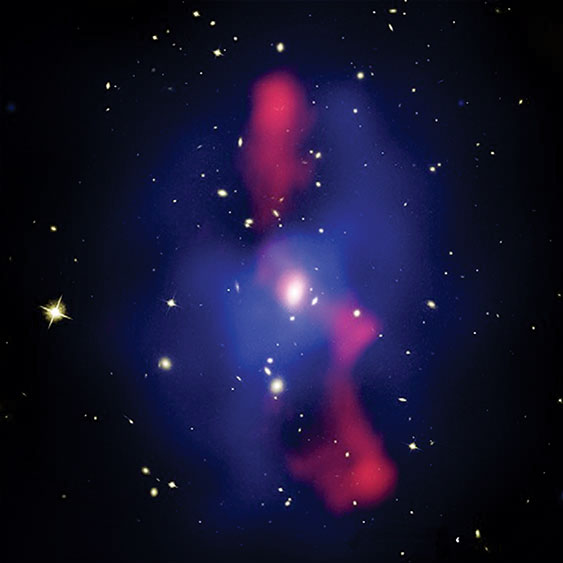
Naively, astronomers might have expected that those dense cluster cores had reached a quiet equilibrium state, even while the cluster outskirts continue to be perturbed by infalling material. But observations suggest the multiphase plasmas in cluster cores have their own complex dynamics full of interesting astrophysics and new challenges.
The weather forecast
Astronomers very much want to discern the bulk motions in the ICM. In its far too brief 38 days in space, the Japanese x-ray satellite Hitomi gave a taste of things to come. With its exquisite spectral resolution, Hitomi directly measured the Doppler line broadening and centroid shifts of the lines from highly ionized iron in the core of the Perseus cluster. At 100–200 km/s, the observed velocities provided the first direct measurements of the streaming and random gas motions in the central regions of a cluster ICM. They also reflected energy inputs from both gravity and the jets from the supermassive black hole. While discovering those exciting signposts of ICM activity, Hitomi also confirmed that the ICM is still quite close to hydrostatic equilibrium.
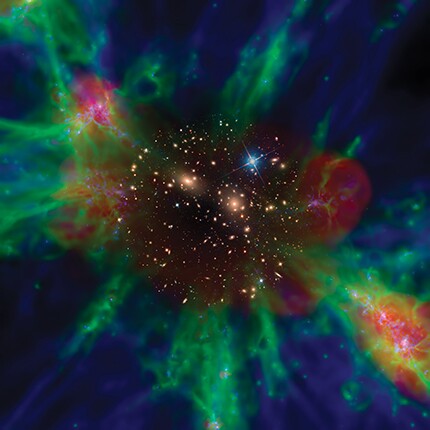
Optical image of Coma cluster galaxies (courtesy of Bob Franke, Focal Pointe Observatory). Background from EAGLE computer simulation illustrating infalling dark matter and baryons (courtesy of Richard Bower; J. Shaye et al., Mon. Not. R. Soc. 446, 521, 2015).
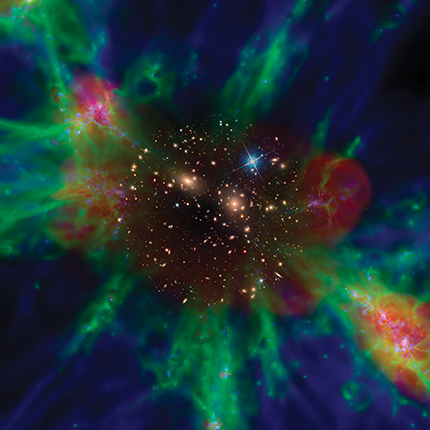
Astronomers are eager for new instrumentation. On the x-ray side, eROSITA, a joint German–Russian venture, is projected to characterize the ICM in 50 000 to 100 000 clusters up from the current tally of approximately 2000. The haul will dramatically expand the capacity for statistical and cosmological studies. The exquisite spectral resolution and sensitivity of XRISM, a joint Japanese–US mission, will map out the details of velocity structures in the ICM. Further down the road, the European satellite ATHENA will allow us to study the history of how the ICM is heated and chemically evolves over cosmic times. Likewise, NASA is considering the Lynx mission, which could probe the diffuse medium in cluster-feeding filaments down to the astonishing low value of about 7 atoms/m3.
Complementing those studies are a new generation of radio telescopes and surveys. At low frequencies, the LOFAR Two-Metre Sky Survey and the Murchison Widefield Array have begun to reveal the extensive cluster synchrotron structures that are no longer visible at high frequencies because of radiative energy losses. Polarization at low frequencies and the new very wide bandwidth capabilities at the Very Large Array will provide detailed probes of magnetic field irregularities in the ICM. And large area surveys using polarization, such as the Very Large Array Sky Survey and the Polarisation Sky Survey of the Universe’s Magnetism on the Australian Square Kilometre Array Pathfinder telescope, will allow statistical studies to connect the magnetic structures in the ICM with other physical properties of clusters far beyond current capabilities. Yet another major leap will occur with the Square Kilometre Array itself.
Even more lies on the horizon. Detector technology has yet to reach the sensitivity needed to realize two other potentially powerful diagnostics: the x-ray inverse Compton radiation from the upscattering of cosmic microwave background photons by the cosmic-ray electrons, and the gamma rays expected from pion decay after they are produced by cosmic-ray and thermal proton collisions. But instrumentation is becoming ever more powerful and computer simulations increasingly sophisticated. The weather outlook for the ICM is both stormy and exciting!
Thanks to many colleagues across the spectrum for their most wise counsel and for support from NSF through grant AST 1714205 to the University of Minnesota.
References
1. M. Wolf, Publ. Astrophys. Inst. Königstuhl-Heidelberg 1, 125 (1902), p. 176;
K. Dolag, trans., University Observatory Munich, Max Planck Institute for Astrophysics.2. F. Zwicky, Helv. Phys. Acta 6, 110 (1933). https://doi.org/10.5169/seals-110267
3. A. Bykov et al., Space Sci. Rev. 188, 141 (2015). https://doi.org/10.1007/s11214-014-0129-4
4. R. Sunyaev, Y. Zel’dovich, Comments Astrophys. Space Phys. 4, 173 (1972).
5. G. Brunetti, T. Jones, Int. J. Mod. Phys. D 23, 1430007 (2014). https://doi.org/10.1142/S0218271814300079
6. F. Owen et al., Astrophys. J. 794, 24 (2014). https://doi.org/10.1088/0004-637X/794/1/24
7. K. Rajpurohit et al., Astrophys. J. 852, 65 (2018). https://doi.org/10.3847/1538-4357/aa9f13
8. B. McNamara et al., Astrophys. J. 698, 594 (2009). https://doi.org/10.1088/0004-637X/698/1/594
